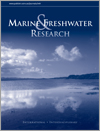Marine and Freshwater Research
Volume 74
Number 8 2023
Microbial community composition of small-drainage estuaries is expected to be mainly composed of coastal organisms. However, results obtained in this study showed that the complexity of the prokaryotic community in such ecosystems is higher than previously thought. Additionally, Urdaibai estuary evidenced to be affected by anthropogenic and terrestrial-origin factors, showing to be in a poor or moderate ecological status according to bacterial indicators. This is of special concern because this estuary is an UNESCO Biosphere reserve.
We investigated whether environmental flows and stocking in combination support a population of a freshwater fish more effectively and cost efficiently than does either action in isolation under various climate-change scenarios. Our model suggests that the application of environmental flows was highly effective in all but the most-extreme climate-change scenarios. Alternatively, the value of stocking increased with an increasing severity of climate change. Under severe climate-change scenarios, such interventions may be successful only to a point.
Transboundary water management has often been obstructed by tensions among the different nation-states. Better transboundary management of Brahmaputra requires a new direction from the current situation of fragmented cooperation, conflicts and disputes among China, India, Bhutan and Bangladesh, and increasing threats of climate change. We find that hydropower-supported energy transitions for clean and affordable energy supply meet the needs and expectations of all nations, especially under the threats of climate change.
An estimation of economic values as perceived by the primary stakeholders of Loktak Lake was conducted employing discrete choice experiment method. Proper accounting of economic values is assumed to be essential for better management of wetland resources. It has been found that there exist considerable levels of observed and unobserved preference heterogeneity among the stakeholders. The willingness to pay, as expressed by local communities, for better management of Loktak Lake highlighted the importance of developing a more inclusive approach in the management of the wetland.
The finescale triggerfish, Balistes polylepis, plays an important role by feeding on a wide range of resources and, hence, generating trophic interactions with numerous species. The most important prey items at two sites in the Gulf of California were the colonial ascidian Lissoclinum fragile at Las Ánimas and the Xanthidae family at San Juan de la Costa.
This study observed the formation of a pair within a group of grey triggerfish (Balistes capriscus) in the laboratory, culminating in reproduction and enabling studies on the larviculture of the species. The results indicated that it is possible to keep small groups of breeders in captivity, but the individualisation of couples may be necessary, because of the aggressiveness towards other individuals. The hatchery phase is still a strong limiting factor for the artificial propagation of the species, because it demonstrates specificity regarding the first exogenous food.
Microplastic (MP) contamination is a threat for freshwater systems worldwide. We evaluated MPs in different insect species, sediment and water in a wastewater basin in Sohag, Egypt. The collector–gatherers (Chironomidae) recorded the highest MP load, the highest bioaccumulation factor (BCF), and the biota-sediment accumulation factor (BSAF), whereas predators (Aeshnidae) had the lowest MP lode. Polyester fibres were the dominant polymer in both water and sediment, and the only type in insects. We concluded that feeding guilds of the insect species may play a role in MP load.
 , David Abad, Aitor Albaina
, David Abad, Aitor Albaina  , Mikel Gutiérrez-Muto
, Mikel Gutiérrez-Muto  , Jorge Langa, Marisol Goñi-Urriza, Maite Orruño, Inés Arana
, Jorge Langa, Marisol Goñi-Urriza, Maite Orruño, Inés Arana  , Andone Estonba and Iratxe Zarraonaindia
, Andone Estonba and Iratxe Zarraonaindia 




